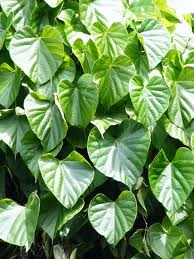| PlantID | 0122 |
| Botanical Name | Tinospora cordifolia |
| Common Name | Guduchi, Giloy |
| Classification | | Kingdom: | Plantae | | Subkingdom: | Tracheobionta | | Division: | Magnoliophyta | | Class: | Magnoliopsida | | Subclass: | Ranunculidae | | Order: | Ranunculales | | Family: | Menispermaceae | | Genus: | Tinospora | | Species: | cordifolia |
|
| Part used | Stem |
| Medicinal Properties | Stem: Bitter, astringent, sweet, thermogenic, anodyne, anthelmintic, alterant, antiperoidic, antispasmodic, anti-inflammatory, antipyretic, antiemetic, digestive, carminative, appetise, stomachic, constipating, cardiotonic, depurative, heamatinic, expectorant, aphrodisiac, rejuvenating, galacto-purifier and tonic. |
| Medicinal Use | It is useful in vitiated conditions of vata, burning sensation, hyperdipsia, helminthiasis, dyspepsia, flatulence, stomachalgia, intermittent fevers, chronic fevers, inflammations, gout, vomitting, cardiac debility, skin diseases, leprosy, erysipelas, anaemia, cough, asthma, general debility, jaundice, seminal weakness, uropathy and splenopathy. |
| Chemistry | It contains tinosporin, columbin, chasmanthin, palmarin, berberine, tinosporon, tinosporic acid, tinosporol, giloin, giloinisin, substituted pyrrolidine, aditerpenoid furanolactone, 18-norclerodane diterpene-O-glucoside, anaryltetrahydrofuranolignan, octacosanol, nonacosan-15-one and beta-sitosterol. |
| Cultivation | The plant is cultivated by stem cutting in the month of May-June. |
| Regional Habitat | Throughout Rajasthan |
| Description | A large extensively spreading glabrous, perennial deciduous twiner with succulent stems and papery bark; leaves: simple, alternate, cordate, entire, glabrous, 7-9 nerved; flowers: yellow in lax racemes, usually solitary; fruits: drupes, red when ripe. Stem: the surfce of the stems appears to be closely studded with warty tubercles and the surface skin is longitudinally fissured. On removal of the surface skin the dark grrenish mucilaginous stem is seen. |
| Image |  |


